An online project under the direction of the CAPE ANN MUSEUM
inv. 27
New England Harbor at Sunrise
Gloucester Harbor at Sunrise
c. 1850 Oil on canvas 24 1/4 x 36 1/4 in. (61.6 x 92.1 cm) No inscription found
|
Supplementary Images
Explore catalog entries by keywords view all keywords »
Historical Materials
Below is historical information related to the Lane work above. To see complete information on a subject on the Historical Materials page, click on the subject name (in bold and underlined).
Oil on canvas
26 1/4 x 41 in.
United States Naval Academy Museum, Annapolis, Md.
Filed under: Boston Harbor »
Preceded by Annisquam as the earliest permanently settled harbor and Gloucester’s original first parish, Gloucester Harbor did not become a seaport of significance until the end of the 17th century. Its earliest fishing activity was focused on nearby grounds in the Gulf of Maine, few vessels venturing further to the banks off Canada. After 1700, as maritime activity was well-established in fishing, shipbuilding, and coastal trade, the waterfront saw the expansion of flake yards for drying fish and wharves for berthing and outfitting vessels, loading lumber and fish, and receiving trade goods. Shipbuilding was also carried on, using shorelines with straight slopes not suited for wharves.
By 1740, the majority of Cape Ann-owned vessels were berthed in Gloucester Harbor; three years later, Watch House Point (now called Fort Point) was armed and fortified. The fishing fleet continued to grow, numbering over 140 vessels by the time of the Revolution. A customs office was established in 1768, resulting in strong protests over seizures of contraband. Revolution brought hardship to the fishing industry, forcing many vessel owners to resort to privateering.
Independence saw a much-diminished fishing fleet and a severely impoverished seaport. With the Federally-sponsored incentive of the codfish bounties, Gloucester fishermen began to rebuild their fishing fleet. By 1790, trade with Surinam was under way, leading to the building and purchase of merchant vessels, new wharves, and improvements to old wharves in Harbor Cove, which had become Gloucester’s center of maritime activity. In addition to shipyards and sail lofts, two ropewalks furnished cordage for rigging.
The first four decades of the 19th century saw fitful growth in the fishing industry, due to the interruptions of war and financial panics. Few wharves were added to the waterfront in that period, and when new ones were built, their purpose was to serve the growing Surinam Trade. Fishing had come to its low point in the 1840s when the railroad reached Gloucester, opening a huge inland market for the fish it caught. The use of ice to keep fish fresh, combined with new and faster fishing schooners to get it quickly to port, sparked a revival in Gloucester’s fishing industry.
As Gloucester’s fishing industry revived, its growth in the Surinam Trade was hampered by its shallow harbor which made berthing of ever larger ships more difficult. Forced to seek a deeper harbor, merchants reluctantly sent their largest ships to Boston for unloading. Between 1850 and 1860, this process continued until ships and warehouses were relocated and their owners commuted to Boston by rail, leaving their old wharves to the fishing fleet. In 1863, the Surinam trade collapsed.
Gloucester’s fishing fleet grew dramatically in the 1850s for more reasons than ice, railroads, and faster schooners. The technology of catching fish also improved dramatically. Hand-line fishing (two hooks on a line) gave way to dory trawling with many hooks on a very long “trawl line,” while fishing for mackerel with hand-lines was replaced by “purse seining,” setting a 1,000-foot-long net in a circle around a school of mackerel. These dramatic improvements in productivity were expensive but made possible by the fishermen organizing a mutual savings bank to serve their needs and a mutual insurance company to cover their risks. These advantages could not be matched by any other fishing communities in New England or in the Canadian Maritime Provinces, sparking a huge migration of fishermen to Gloucester. These newcomers were welcomed to fill a growing work force while Gloucester’s native work force moved on to other, less dangerous, occupations.
Lane’s depictions of Gloucester’s waterfront best illustrate the period before 1850. After that date, his attention turned more to the Harbor’s outer shores, to nearby communities such as Manchester, to New York, back to Boston, and north to Maine. While his lapse of interest is regrettable, the scenes and activity he missed were becoming popular with photographers while his earlier waterfront views are nowhere else to be found.
–Erik Ronnberg
References:
Dates and happenings were based on (or confirmed by):
Mary Ray and Sarah V. Dunlap, “Gloucester, Massachusetts Historical Time-Line (Gloucester: Gloucester Archives Committee, 2002).
Improvements to Gloucester’s fishing technology, management, and financing are based on:
Wayne O’ Leary, “Maine Sea Fisheries” (Boston: Northeastern University Press, 1996), pp. 166–179 (fishing technology), 235–251 (management and financing), and 235–251 (in-migration to Gloucester).
Photograph
Cape Ann Museum Library & Archive
Also filed under: Gloucester Harbor, Inner / Harbor Cove » // Historic Photographs » // Schooner (Fishing) »
Photograph
Cape Ann Museum Library & Archive
Ignatius Weber's windmill (now defunct) is shown.
Also filed under: Flake Yard » // Fort (The) and Fort Point » // Gloucester Harbor, Inner / Harbor Cove » // Historic Photographs » // Rogers's (George H.) wharves » // Schooner (Fishing) » // Windmill »
44 x 34 in.
John Hanson, Publisher
Cape Ann Museum Library & Archive
"Map of the Towns of Gloucester and Rockport, Massachusetts. H.F. Walling, Civil Engineer. John Hanson, Publisher. 1851. Population of Gloucester in 1850 7,805. Population of Rockport in 1850 3,213."
Also filed under: Fort (The) and Fort Point » // Low (Frederick G.) wharves » // Maps » // Rogers's (George H.) wharves » // Town / Public Landings » // Windmill »
Stereograph card
Cape Ann Museum Library & Archive
This view of Gloucester's Inner Harbor shows three square-rigged vessels in the salt trade at anchor. The one at left is a (full-rigged) ship; the other two are barks. By the nature of their cargos, they were known as "salt ships" and "salt barks" respectively. Due to their draft (too deep to unload at wharfside) they were partially unloaded at anchor by "lighters" before being brought to the wharves for final unloading.
– Erik Ronnberg
Also filed under: Bark / Barkentine or Demi-Bark » // Historic Photographs » // Salt »
Stereograph card
Cape Ann Museum Library & Archive
"Said schooner was captured about the first of September, 1871, by Capt. Torry, of the Dominion Cutter 'Sweepstakes,' for alleged violation of the Fishery Treaty. She was gallantly recaptured from the harbor of Guysboro, N.S., by Capt. Harvey Knowlton., Jr., (one of her owners,) assisted by six brave seamen, on Sunday night, Oct. 8th. The Dominion Government never asked for her return, and the United States Government very readily granted her a new set of papers."
Also filed under: Fishing » // Historic Photographs » // Schooner (Fishing) »
Stereograph card
Cape Ann Museum Library & Archive
Stereo view showing Gloucester Harbor after a heavy snowfall
Also filed under: Gloucester Harbor, Inner / Harbor Cove » // Historic Photographs »
Wood, metal, and paint
20 1/4 x 10 1/4 x 10 1/2 in., scale: 1/2" = 1'
Made for the Columbian Exposition, Chicago, 1892–93
Cape Ann Museum, from Gloucester Chamber of Commerce
The wharf is built up of "cribs", square (sometimes rectangular) frames of logs, resembling a log cabin, but with spaces between crib layers that allow water to flow freely through the structure.Beams are laid over the top crib, on which the "deck" of the wharf is built. Vertical pilings (or "spiles" as locally known) are driven at intervals to serve as fenders where vessels are tied up.
– Erik Ronnberg
Also filed under: Cob / Crib Wharf »
Cape Ann Museum Library & Archive
Also filed under: Fishing » // Historic Photographs »
Cape Ann Museum Library & Archive (2013.068)
Schooner fleet anchored in the inner harbor. Looking east from Rocky Neck, Duncan's Point wharves and Lane house (at far left), Sawyer School cupola on Friend Street.
Also filed under: Duncan's Point » // Gloucester Harbor, Inner / Harbor Cove » // Historic Photographs » // Schooner (Fishing) »
The historic New Hampshire port town of Portsmouth has not proven to be the subject of any of Lane's pictures, but there are several for which the topography and buildings suggest a likely identification.
"Nightingale" was built at Portsmouth, New Hampshire by Samuel Hanscomin 1851. She was launched in June but remained in Portsmouth until July when she was towed to Boston, to "await the untangling of her builder's financial embarrassment and her sale to a prominent Boston shipping firm." (1) There is no definite portrait of "Nightingale," but Ronnberg has proposed that New England Harbor at Sunrise, c.1850 (inv. 27) depicts her in Portsmouth. (2)
References:
1. Erik Ronnberg, "Imagery and Types of Vessels," in Paintings by Fitz Hugh Lane, by John Wilmerding (Washington, DC: Harry N. Abrams, 1988), 74.
2. Ibid.
In general, brigs were small to medium size merchant vessels, generally ranging between 80 and 120 feet in hull length. Their hull forms ranged from sharp-ended (for greater speed; see Brig "Antelope" in Boston Harbor, 1863 (inv. 43)) to “kettle-bottom” (a contemporary term for full-ended with wide hull bottom for maximum cargo capacity; see Ships in Ice off Ten Pound Island, Gloucester, 1850s (inv. 44) and Boston Harbor, c.1850 (inv. 48)). The former were widely used in the packet trade (coastwise or transoceanic); the latter were bulk-carriers designed for long passages on regular routes. (1) This rig was favored by Gloucester merchants in the Surinam Trade, which led to vessels so-rigged being referred to by recent historians as Surinam brigs (see Brig "Cadet" in Gloucester Harbor, late 1840s (inv. 13) and Gloucester Harbor at Dusk, c.1852 (inv. 563)). (2)
Brigs are two-masted square-rigged vessels which fall into three categories:
Full-rigged brigs—simply called brigs—were fully square-rigged on both masts. A sub-type—called a snow—had a trysail mast on the aft side of the lower main mast, on which the spanker, with its gaff and boom, was set. (3)
Brigantines were square-rigged on the fore mast, but set only square topsails on the main mast. This type was rarely seen in America in Lane’s time, but was still used for some naval vessels and European merchant vessels. The term is commonly misapplied to hermaphrodite brigs. (4)
Hermaphrodite brigs—more commonly called half-brigs by American seamen and merchants—were square-rigged only on the fore mast, the main mast being rigged with a spanker and a gaff-topsail. Staysails were often set between the fore and main masts, there being no gaff-rigged sail on the fore mast.
– Erik Ronnberg
References:
1. Howard I. Chapelle, The National Watercraft Collection (Washington, DC: Smithsonian Institution, 1960), 64–68.
2. Alfred Mansfield Brooks, Gloucester Recollected: A Familiar History (Gloucester, MA: Peter Smith, 1974), 62–74. A candid and witty view of Gloucester’s Surinam Trade, which employed brigs and barks.
3. R[ichard] H[enry] Dana, Jr., The Seaman's Friend (Boston: Thomas Groom & Co., 1841. 13th ed., 1873), 100 and Plate 4 and captions; and M.H. Parry, et al., Aak to Zumbra: A Dictionary of the World's Watercraft (Newport News, VA: The Mariners’ Museum, 2000), 95.
4. Parry, 95, see Definition 1.
Oil on canvas
17 1/4 x 25 3/4 in.
Cape Ann Museum, Gloucester, Mass., Gift of Isabel Babson Lane, 1946 (1147.a)
Photo: Cape Ann Museum
Detail of brig "Cadet."
Also filed under: "Cadet" (Brig) »
Painting on board
72 x 48 in.
Collection of Erik Ronnberg
Chart showing the voyage of the brig Cadet to Surinam and return, March 10–June 11, 1840.
Also filed under: "Cadet" (Brig) » // Surinam Trade »
Schooners in Lane’s time were, with few exceptions, two-masted vessels carrying a fore-and-aft rig having one or two jibs, a fore staysail, gaff-rigged fore- and main sails, and often fore- and main topsails. One variant was the topsail schooner, which set a square topsail on the fore topmast. The hulls of both types were basically similar, their rigs having been chosen for sailing close to the wind. This was an advantage in the coastal trade, where entering confined ports required sailing into the wind and frequent tacking. The square topsail proved useful on longer coastwise voyages, the topsail providing a steadier motion in offshore swells, reducing wear and tear on canvas from the slatting of the fore-and-aft sails. (1)
Schooners of the types portrayed by Lane varied in size from 70 to 100 feet on deck. Their weight was never determined, and the term “tonnage” was a figure derived from a formula which assigned an approximation of hull volume for purposes of imposing duties (port taxes) on cargoes and other official levies. (2)
Crews of smaller schooners numbered three or four men. Larger schooners might carry four to six if a lengthy voyage was planned. The relative simplicity of the rig made sail handling much easier than on a square-rigged vessel. Schooner captains often owned shares in their vessels, but most schooners were majority-owned by land-based firms or by individuals who had the time and business connections to manage the tasks of acquiring and distributing the goods to be carried. (3)
Many schooners were informally “classified” by the nature of their work or the cargoes they carried, the terminology coined by their owners, agents, and crews—even sometimes by casual bystanders. In Lane’s lifetime, the following terms were commonly used for the schooner types he portrayed:
Coasting schooners: This is the most general term, applied to any merchant schooner carrying cargo from one coastal port to another along the United States coast (see Bar Island and Mt. Desert Mountains from Somes Settlement, 1850 (inv. 401), right foreground). (4)
Packet schooners: Like packet sloops, these vessels carried passengers and various higher-value goods to and from specific ports on regular schedules. They were generally better-maintained and finished than schooners carrying bulk cargoes (see The Old Fort and Ten Pound Island, Gloucester, 1850s (inv. 30), center; and Gloucester Inner Harbor, 1850 (inv. 240), stern view). (5)
Lumber schooners: Built for the most common specialized trade of Lane’s time, they were fitted with bow ports for loading lumber in their holds (see View of Southwest Harbor, Maine: Entrance to Somes Sound, 1852 (inv. 260)) and carried large deck loads as well (Stage Rocks and the Western Shore of Gloucester Outer Harbor, 1857 (inv. 8), right). Lumber schooners intended for long coastal trips were often rigged with square topsails on their fore masts (see Becalmed Off Halfway Rock, 1860 (inv. 344), left; Maverick House, 1835 (not published); and Lumber Schooner in a Gale, 1863 (inv. 552)). (6)
Schooners in other specialized trades. Some coasting schooners built for carrying varied cargoes would be used for, or converted to, special trades. This was true in the stone trade where stone schooners (like stone sloops) would be adapted for carrying stone from quarries to a coastal destination. A Lane depiction of a stone schooner is yet to be found. Marsh hay was a priority cargo for gundalows operating around salt marshes, and it is likely that some coasting schooners made a specialty of transporting this necessity for horses to urban ports which relied heavily on horses for transportation needs. Lane depicted at least two examples of hay schooners (see Gloucester Harbor, 1850s (inv. 391), left; and Coasting Schooner off Boon Island, c.1850 (inv. 564)), their decks neatly piled high with bales of hay, well secured with rope and tarpaulins.
– Erik Ronnberg
References:
1. Howard I. Chapelle, The History of American Sailing Ships (New York: W.W. Norton & Co., 1935), 258. While three-masted schooners were in use in Lane’s time, none have appeared in his surviving work; and Charles S. Morgan, “New England Coasting Schooners”, The American Neptune 23, no. 1 (DATE): 5–9, from an article which deals mostly with later and larger schooner types.
2. John Lyman, “Register Tonnage and its Measurement”, The American Neptune V, nos. 3–4 (DATE). American tonnage laws in force in Lane’s lifetime are discussed in no. 3, pp. 226–27 and no. 4, p. 322.
3. Ship Registers of the District of Gloucester, Massachusetts, 1789–1875 (Salem, MA: The Essex Institute, 1944). Vessels whose shipping or fishing voyages included visits to foreign ports were required to register with the Federal Customs agent at their home port. While the vessel’s trade or work was unrecorded, their owners and master were listed, in addition to registry dimensions and place where built. Records kept by the National Archives can be consulted for information on specific voyages and ports visited.
4. Howard I. Chapelle, The National Watercraft Collection (Washington, DC: Smithsonian Institution, 1960), 40, 42–43.
5. Ibid., 42–43, 73.
6. Ibid., 74–76.
A topsail schooner has no tops at her foremast, and is fore-and-aft rigged at her mainmast. She differs from an hermaphrodite brig in that she is not properly square-rigged at her foremast, having no top, and carrying a fore-and-aft foresail instead of a square foresail and a spencer.
Wood rails, metal rollers, chain; wood cradle. Scale: ½" = 1' (1:24)
Original diorama components made, 1892; replacements made, 1993.
Cape Ann Museum, from Gloucester Chamber of Commerce, 1925 (2014.071)
A schooner is shown hauled out on a cradle which travels over racks of rollers on a wood and metal track.
Also filed under: Burnham Brothers Marine Railway » // Marine Railways »
Glass plate negative
Collection of Erik Ronnberg
Also filed under: Lobstering »
Details about Maine's lumber trade in 1855, see pp. 250–52
Also filed under: Castine » // Lumber Industry »
The term "ship," as used by nineteenth-century merchants and seamen, referred to a large three-masted sailing vessel which was square-rigged on all three masts. (1) In that same period, sailing warships of the largest classes were also called ships, or more formally, ships of the line, their size qualifying them to engage the enemy in a line of battle. (2) In the second half of the nineteenth century, as sailing vessels were replaced by engine-powered vessels, the term ship was applied to any large vessel, regardless of propulsion or use. (3)
Ships were often further defined by their specialized uses or modifications, clipper ships and packet ships being the most noted examples. Built for speed, clipper ships were employed in carrying high-value or perishable goods over long distances. (4) Lane painted formal portraits of clipper ships for their owners, as well as generic examples for his port paintings. (5)
Packet ships were designed for carrying capacity which required some sacrifice in speed while still being able to make scheduled passages within a reasonable time frame between regular destinations. In the packet trade with European ports, mail, passengers, and bulk cargos such as cotton, textiles, and farm produce made the eastward passages. Mail, passengers (usually in much larger numbers), and finished wares were the usual cargos for return trips. (6) Lane depicted these vessels in portraits for their owners, and in his port scenes of Boston and New York Harbors.
Ships in specific trades were often identified by their cargos: salt ships which brought salt to Gloucester for curing dried fish; tea clippers in the China Trade; coffee ships in the West Indies and South American trades, and cotton ships bringing cotton to mills in New England or to European ports. Some trades were identified by the special destination of a ship’s regular voyages; hence Gloucester vessels in the trade with Surinam were identified as Surinam ships (or barks, or brigs, depending on their rigs). In Lane’s Gloucester Harbor scenes, there are likely (though not identifiable) examples of Surinam ships, but only the ship "California" in his depiction of the Burnham marine railway in Gloucester (see Three Master on the Gloucester Railways, 1857 (inv. 29)) is so identified. (7)
– Erik Ronnberg
References:
1. R[ichard)] H[enry] Dana, Jr., The Seaman’s Friend, 13th ed. (Boston: Thomas Groom & Co., 1873), p. 121 and Plate IV with captions.
2. A Naval Encyclopaedia (Philadelphia: L. R. Hamersly & Co., 1884), 739, 741.
3. M.H. Parry, et al., Aak to Zumbra: A Dictionary of the World’s Watercraft (Newport News, VA: The Mariners’ Museum, 2000), 536.
4. Howard I. Chapelle, The History of American Sailing Ships (New York: W.W. Norton & Co., 1935), 281–87.
5. Ibid.
6. Howard I. Chapelle, The National Watercraft Collection (Washington, DC: Smithsonian Institution, 1960), 26–30.
7. Alfred Mansfield Brooks, Gloucester Recollected: A Familiar History (Gloucester, MA: Peter Smith, 1974), 67–69.
Photograph
From American Clipper Ships 1833–1858, by Octavius T. Howe and Frederick C. Matthews, vol. 1 (Salem, MA: Marine Research Society, 1926).
Photo caption reads: "'Golden State' 1363 tons, built at New York, in 1852. From a photograph showing her in dock at Quebec in 1884."
Also filed under: "Golden State" (Clipper Ship) »
Oil on canvas
24 x 35 in.
Peabody Essex Museum, Salem, Mass.
Walters' painting depicts the "Nonantum" homeward bound for Boston from Liverpool in 1842. The paddle-steamer is one of the four Clyde-built Britannia-class vessels, of which one is visible crossing in the opposite direction.
View related Fitz Henry Lane catalog entries (2) »
Also filed under: Packet Shipping » // Walters, Samuel »
The Whitehall Boat, like the yawl boat, is an early nineteenth-century refinement of an earlier ship's boat type—very likely the gigs of warships. Builders of the earliest examples are believed to have been former navy shipyard employees whose knowledge was put to use building similar boats in their shops on Whitehall Street in lower Manhattan. Recognized as a distinct small boat type in the 1830s, by mid-nineteenth century the Whitehall Boat was in use in most American seaports. (1)
Lane depicted Whitehall Boats in a number of his paintings of major ports, including New York Harbor, c.1855 (inv. 46) (right center foreground), which shows a large example, rowed by four men witha single passenger in the stern, illustrating one of its chief uses as a water taxi. These craft were also used by ship chandlers to deliver ship supplies, and most notoriously by "crimps" who used them to deliver drunken seamen to outbound ships needing crews. Not intended for use in open sea, their light yet strong construction, fine lines, and maneuverability made them ideal for in-harbor work. (2)
Other Whitehall boats appear in the foregrounds of Boston and other unidentified major port scenes (see New England Harbor at Sunrise, c.1850 (inv. 27), Brig "Antelope" in Boston Harbor, 1863 (inv. 43), The "Britannia" Entering Boston Harbor, 1848 (inv. 49), Boston Harbor, Sunset, 1850–55 (inv. 242), The "Constitution" in Boston Harbor, c.1848–49 (inv. 243), and Clipper Ship "Southern Cross" in Boston Harbor, 1851 (inv. 253)).
References:
1. Howard I. Chapelle, American Small Sailing Craft (New York: W.W. Norton & Co., 1951), 195–96.
2. Ibid., 196–99.
Oil on canvas
36 x 60 1/4 in.
Museum of Fine Arts, Boston, Gift of Maxim Karolik for the M. and M. Karolik Collection of American Paintings, 1815–65 (48.446)
Detail of Whitehall boat.
Also filed under: New York Harbor »
Vessel ornamentation assumed two forms: carvings and color schemes. Carvings, or "ship carvings," as they are called by maritime scholars, are usually crafted in wood and painted or gilt. Many vessels were too small or their owners too frugal to permit carved embellishments, in which cases the enhancement of the vessel's color scheme was a practical alternative. This can be seen in many of the coastal vessels along the new England coast. Pinkies and Chebacco boats had handsome color schemes using only black and green with white sheer lines and limited use of red and yellow. Other combinations of inexpensive pigments were used to improve the simple looks of sloops and schooners in the packet trade, while small pleasure craft and pilot schooners enhanced their appearance in similar ways. Clipper ship owners, finding their vessels' appearance impressive without adding color, settled for unrelieved black hulls. Naval vessels as well preserved their formidable looks with black, relieved only with a white belt in way of the gunports.
The more elaborate ship carvings can be classified in the following categories:
Billetheads: mounted on the bow, at the end of a simple gammon knee, or on the forward end of an elaborate stem-head, they can be scrolls of less or greater intricacy, or sometimes the heads of animals, eagles being the most common. Examples of a sea serpent's head, a pointing hand, and other animal heads have been found. (See Brig "Cadet" in Gloucester Harbor, late 1840s (inv. 13); Brig "Antelope" in Boston Harbor, 1863 (inv. 43); and Brig Off the Maine Coast, 1851 (inv. 241))
Figureheads: mounted on bows of larger vessels, often with elaborate stem joinerwork (trailboards and headboards with associated knees and rails). Usually these were full-length figures representing the ship's owner, a famous citizen, a mythological person or animal, or an eagle. (See Portrait of the "National Eagle", 1853 (inv. 35) (eagle); New York Harbor, c.1855 (inv. 46); The "Britannia" Entering Boston Harbor, 1848 (inv. 49) (female figures); The Ships "Winged Arrow" and "Southern Cross" in Boston Harbor, 1853 (inv. 54) (dragon and eagle); "Starlight" in Harbor, c.1855 (inv. 249) (dragon); and Steam demi bark Antelope, 615 tons, c.1855 (inv. 375) (antelope))
Trailboards: carved vines or scrollwork abaft the figurehead which trail aft along the stem head in a graceful descending arc, terminating at the hawse pipes. They are usually gilt and frequently ornamented with carved rosettes and other devices. (See Brig "Cadet" in Gloucester Harbor, late 1840s (inv. 13); Portrait of the "National Eagle", 1853 (inv. 35); Brig "Antelope" in Boston Harbor, 1863 (inv. 43); New York Harbor, c.1855 (inv. 46); and The Ships "Winged Arrow" and "Southern Cross" in Boston Harbor, 1853 (inv. 54))
Headboards: boards mounted to headrails connecting the figurehead to the ship's mainrail at the catheads. While seldom given any decorative carvings, the vessel's nameboards were often mounted to them. (See Brig "Cadet" in Gloucester Harbor, late 1840s (inv. 13); Portrait of the "National Eagle", 1853 (inv. 35); Brig "Antelope" in Boston Harbor, 1863 (inv. 43); The Ships "Winged Arrow" and "Southern Cross" in Boston Harbor, 1853 (inv. 54); Clipper Ship "Southern Cross" in Boston Harbor, 1851 (inv. 253); and Mary Ann, 1846 (inv. 309))
Catheads: Carved lion heads mounted on the outboard ends of the cathead knees. This term is so archaic that the knees and carvings are treated as one and the same, as in their use, i.e. "catting the anchor" (securing the anchor ring to the cathead). (See Brig "Antelope" in Boston Harbor, 1863 (inv. 43); and An American Frigate Hove-to Off the New England Coast (inv. 535))
Quarterboards: Name boards mounted to the vessel's side near the stern, they usually had ornamental edge moldings and sometimes stars or simple scrollwork at each end of the name. (See Portrait of the "National Eagle", 1853 (inv. 35); Mary Ann, 1846 (inv. 309); and Spitfire Entering Boston Harbor (inv. 536))
Transom arches: arch-form panels fitted to the transom, often over gallery lights (windows) or other carvings. They usually have edge moldings, decorative scrollwork, and sometimes a bust or other carved figure at the center.
Other transom carvings: carved eagles, busts, scrollwork and coats of arms can occupy the space between the transom arch and the sternboard. If galleries are present, carved scrollwork may be fitted between the frames of the gallery lights. (See Boston Harbor, c.1850 (inv. 48); The Topsail Schooner "Kamehameha III" in Boston Harbor, 1846 (inv. 301) (eagle); Baltimore Harbor, 1850 (inv. 400) (eagle); and Rough Sea, Schooners, c.1856 (not published) (eagle and flags))
Sternboard: often the bottom plank of the transom on which the vessel's name is carved or painted, seldom with decoration (stars or scrollwork). There is usually simple protective molding above and below the lettering.
Sideboards, or gangway boards: boards on either side of an entry way at main rail level on a large ship, usually between the main and mizen masts. They are carved and painted or (if of fine hardwood) varnished. Most commonly seen on larger vaval vessels, packet ships, and clipper ships.
– Erik Ronnberg
References:
1. Brewington, M. V., Shipcarvers of North America, (Barre, MA: Barre Publishing Co., 1962).
2. The American Neptune, Pictorial Supplement XIX, "The Art of the Shipcarver" (Salem, MA: The Peabody Museum, 1977).
3. Ship Figureheads (Boston: State Street Trust Co., n.d.).
4. Edouard A. Stackpole, Figureheads & Carvings at Mystic Seaport (Mystic, CT: The Marine Historical Association, Inc., 1964).
Carved wood with paint and gilt
12 x 22 x 8 in.
Cape Ann Museum. Gift of George W. Woodbury, 1936 (747)
This sea serpent billet head came from the schooner "Diadem" which was built in Essex, Massachusetts, in 1855 and owned by D. Elwell Woodbury and John H. Welsh of Gloucester.
Sea serpents were reportedly sighted here on Cape Ann from colonial times through the mid-nineteenth century. In 1817, more than 50 people, many of them prominent members of the community, reported seeing a serpent in the waters of Gloucester Harbor just off Pavilion Beach. So credible were the reports that the Linnaean Society of New England collected depositions from witnesses and published their findings in a small pamphlet entitled Report of a Committee of the Linnaean Society of New England relative to a Large Marine Animal Supposed to be A Serpent, seen Near Cape Ann, Massachusetts, in August 1817.
Also filed under: Objects » // Pavilion (Publick) Beach »
.jpg)
.jpg)
.jpg)
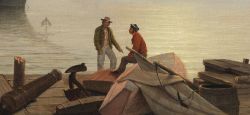


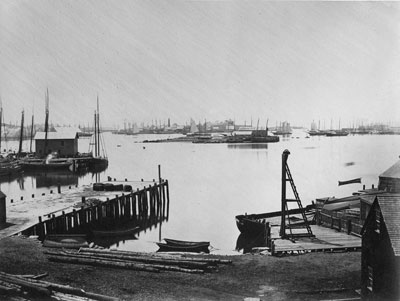


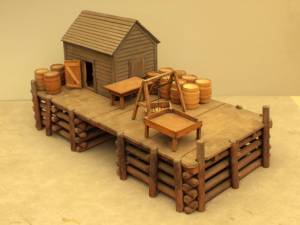

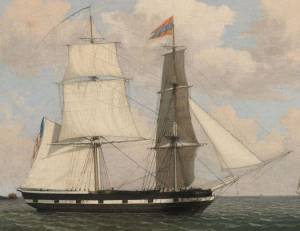

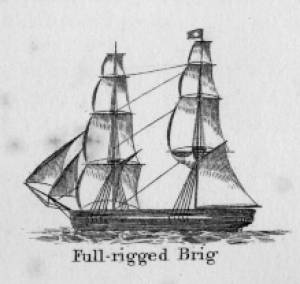

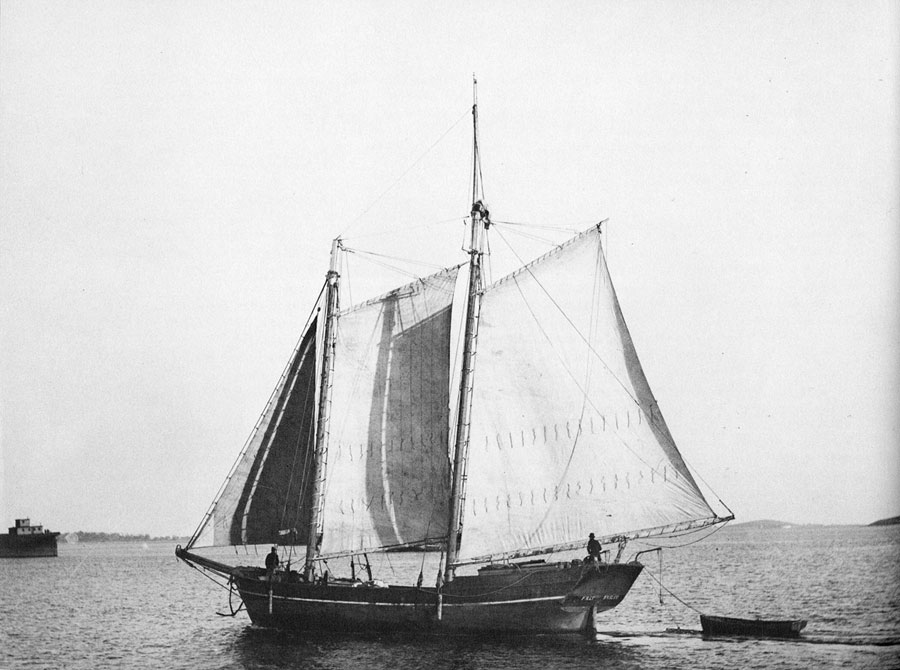
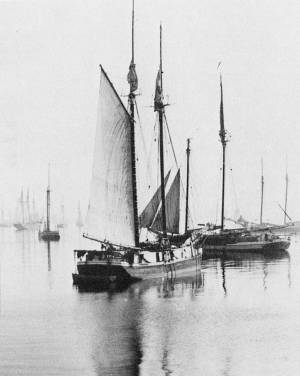


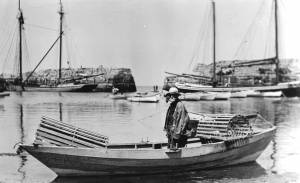

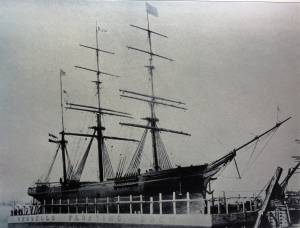
_sm.jpg)

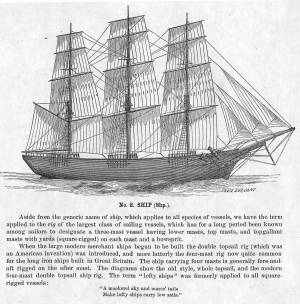
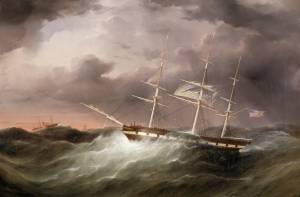


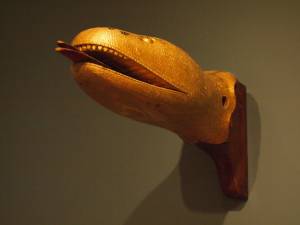
Commentary
Lane’s harbor scenes fall into two broad categories. The first is the harbor at work, full of energy and activity, with vessels and men engaged in a fascinating array of tasks. The second category is the harbor at rest, usually depicted in the calm of early morning or evening, with vessels lying at anchor drying their sails and a few men idling around the docks or rowing through the still water.
This is one of Lane’s finest paintings of a harbor at rest. There is an epic quality to it, as if great things are happening on a grand stage. The seamen in the foreground are no dockside idlers but appear to be engaged in a Socratic dialogue, the standing man making a point that has the seated man’s rapt attention.
At one time this painting was titled Gloucester Harbor at Sunrise. Erik Ronnberg has proposed that the location of the sun, and the piers that face open water could indicate that the painting is of Portsmouth, New Hampshire—the harbor there aligns on this axis. Also, in the center of the composition is a clipper ship that is noteworthy for its elaborate headrails and moldings and its small figurehead in the likeness of a woman. As Ronnberg has also noted, this slightly outdated beakhead decoration is similar to that of a clipper called "Nightingale," built in Portsmouth in 1851.
There is a quality of history painting to this work. Instead of the European model where kings and noble generals are shown against a glorious background at some triumphant moment, here is the American version—a vision of the new world. The background is simple Nature: sunrise over a harbor that is modest yet made glorious by its golden aura. The vessels are merchant ships—not warships—yet magnificent, particularly the three-masted clipper, as beautiful and functional as anything ever created, and handmade by simple carpenters. The seamen on the dock are citizens of this new world, engaged in a dignified dialogue while seated on an overturned dory draped with a canvas sail, rather than a flag or coat of arms. Here is a vision of America with all her egalitarian virtues on display in the optimistic light of early morning.
Lane has achieved this grandeur by composing the picture using a series of triangles to create stability and to focus attention where he wants it. The men stand at the apex of the foreground triangle that is created by the cannon on the dock and the mast and sail on the right. All of these elements point to the standing man who, with his companion, both smartly dressed and hatted, is painted in more detail than most of Lane’s seamen (see detail below). This vignette is a beautiful piece of painting. The dock is a study in black and grays set off against a surprisingly pink dory: a perfect harmony.
The other major triangle is upside down. The space of the sky and sun are bounded by the ships on either side, with the apex of the triangle pointing down at the men on the dock, adding to their importance in the composition. A secondary triangle runs from the men on the dock up to the top of the three-master, and down the line of sails on the left. The grouping of vessels on the right forms another triangle. Every element of this work is masterfully painted in perfectly graduated tonalities that fill the scene with a luminous, diffused sunlight.
Recent infrared images made by the conservators of the Cleveland Museum of Art show that Lane made very few changes in the pencil drawings of the vessels, while he drew and redrew the figures in the foreground.
– Sam Holdsworth
[+] See More